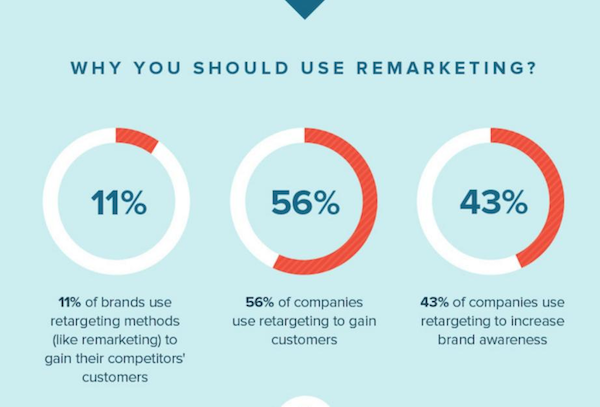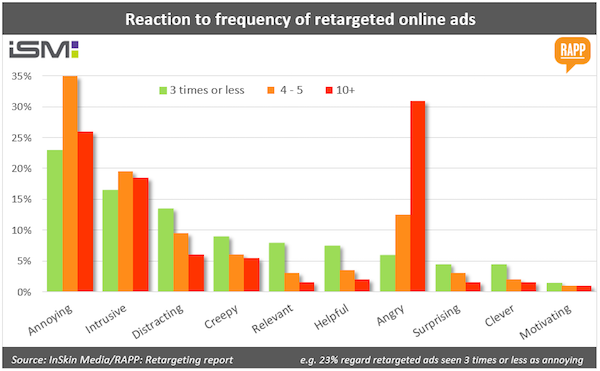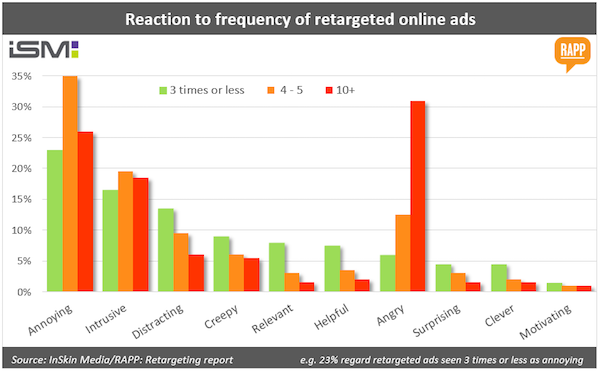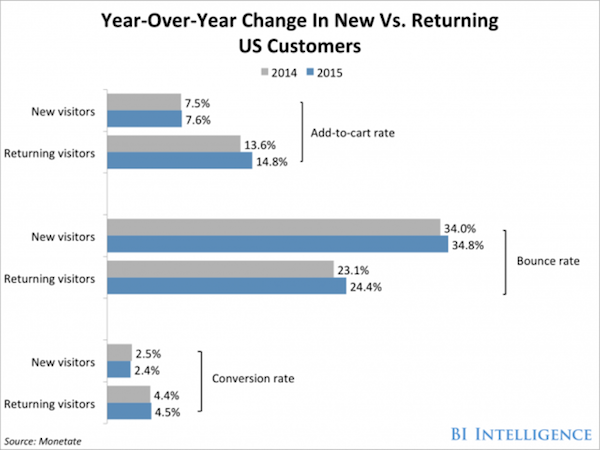When it comes to a retargeting strategy, there’s a fine line between helpful and annoying – which side of the line do you fall on?
We’ve got some bad news. People are catching on to your marketing tactics. And frankly, they’re getting smart enough to realize what you’re doing when they start getting ads for the products they just looked at on your website.
Don’t worry, we aren’t here to tell you to stop remarketing and building relationships with your customer base. In fact, if you aren’t already in the retargeting game, you need to be.
The statistics suggest that 98% of visitors leave your store without purchasing anything during their first visit. If you don’t have a retargeting plan in place you’re going to lose these sales. Without reminding customers about what they liked at your store, your much less likely to capture sales from these visitors and may not see a high visitor return rate.
Many companies claim that their retargeting practices provide them higher conversion rates. Some say they’ve seen conversion rates as high as 50-60% from their retargeting strategies. This is why we want you to continue getting in front of your customers – but you need to stop retargeting in the wrong ways.
Just because people are realizing what you’re marketing efforts are doing, doesn’t mean they don’t want to see these ads. They obviously have some effect on their purchasing behavior if companies are seeing conversion rates from them in the 50-60% range.
Retargeting is a fine line you have to very carefully walk on. Done right, you’ll see increased sales and customer loyalty. But if it’s done wrong, you could quickly annoy, frustrate, and lose customers.
Image courtesy of Neil Patel
Retargeting efforts do more than just convert customers from visitors to customers. The benefits can also include brand awareness and beating the competition.
To start, let’s take a look at what’s wrong with the retargeting tactics many companies are using today
The Wrong Way to Retarget Customers.
Have you ever been followed around by a retargeting ad that just never seems to go away? You swear you’ve seen it at least 30 times this week, and who knows how many last week. It’s like, you’ve moved on with your life, but that shirt you looked at a month ago just can’t get the picture.
You’re not alone. Ad frequency is a big problem in today’s retargeting tactics. People don’t want to keep seeing the same ads over and over again. Once someone sees an ad five or more times, they tend to view it as annoying or intrusive.
The example above about the shirt that you just can’t shake goes beyond annoying and it’s much more likely to make anger people than to bring them back to your site.
Image courtesy of Neil Patel
Just throwing your name out in front of customers isn’t going to boost your sales. The harder you try and the more you promote your products and company to customers will only discourage them from purchasing your products – unless of course, you’re doing it in the right way.
Marketing to People in the Wrong Place, at the Wrong Time.
Another issue that companies are running into when it comes to retargeting is knowing when and where to reach potential customers. All too often, we as marketers want to show ROI as fast as we can – leading us to forget about the journey a customer takes from start to finish.
If you’re serving a new visitor the same ads as a loyal customer, you’re probably missing the target and those two people aren’t feeling the same connection to your brand. You need to warm up that new visitor with a welcome campaign to build your new relationship. Then, when the time is right (if the time is ever right), they can be grouped into the customer loyalty group.
Another example of this is showing someone an ad for a product they just purchased. First off, this is just a big waste of money for you. Secondly, reminding someone of a product they just purchased seems unproductive and could come off as confusing and annoying to shoppers.
You’re also going to want to do a little research and know where to target your customers. If your company sells car parts, you want to make sure your ads are appearing on other websites related to car parts — not on websites designed to share makeup tips and tutorials. When an ad is irrelevant, it is ignored.
As bad ads continue to circulate the internet, people are starting to fight back. 40% of people use ad blockers — that number proves to us that people truly are outsmarting the marketing tactics of the past. Our retargeting mindset needs to evolve to meet the marketing needs of the future.
Customer Journey Retargeting: The Marketing of the Future.
At this point, you’re probably a little unsure of where you should take your retargeting strategy. It might seem like reaching your audiences and improving conversion rates seems like a long lost goal. We’re here to tell you that it really isn’t that hard. You just need to have a plan in place and understand your customers.
Remember that 70% of visitors are likely to convert and that number is high enough to continue forward with your retargeting marketing. You just need to know how to reach them the right way. So what’s the right way? Customer journey retargeting.
Customer journey retargeting is the idea of meeting people at the appropriate stage of the buyer’s cycle. Meaning, new visitors receive information that relates to their current stage and is seeing different retargeting ads than someone who is at the purchasing stage of the cycle.
By marketing to your customers based on their spot in the journey you should expect to the following benefits:
- Higher conversion rates
- Improved sales numbers
- Customer loyalty and increased return visitors
- Brand awareness
This targeting strategy allows for brands to stand out, without annoying and driving visitors away due to too many ads or putting the wrong ads in front of them. By meeting your customers where they are, you’re much more likely to improve conversion rates and boost the profitability of your online store.
Let’s take a look at the stages you should outline for your visitor base, from potential customer to a loyal follower.
Image courtesy of Business 2 Community
Ideally, this is the exact path you want your site visitors to follow. Of course, this cycle would only happen in a perfect world but shows a great outline of how retargeting works from start to finish. You’ve got to have a plan in place to target customers if that first retargeting ad doesn’t bring the visitor back.
The First-Time Visitor:
This stage identifies someone who has visited your site for the first time. This person may have only visited your home page, or a few other pages and left. They may have ended up on your site on accident or maybe in the research stage of their buyer’s journey — this is an opportunity to begin building a relationship with this visitor.
Send this visitor more informative information. Maybe encourage them to subscribe to your newsletter to learn more about your company or share with them some of your most popular items. Encourage the visitor to come back to your site and learn more about your company. You don’t want to seem pushy with this customer segment, first impressions are a deal-breaker.
The Viewed a Couple Products, Then Left Visitor:
So, this person has viewed a few more pages and checked out a product or two on your website — great! We’re one step closer to this person making it through the funnel and becoming a purchasing customer. Now it’s time to help push them through to the next stage.
This visitor will be much more receptive to ads reminding them about the products they were looking at on your site — just keep in mind how often you’re retargeting them. A great way to promote products and build trust with new visitors is to share ratings and reviews from other customers just like them.
The Added Something to My Cart Then Left Visitor:
Anyone in the e-commerce space knows that a big chunk of visitors — around 69% abandoned their shopping carts before making a purchase. These visitors are much more likely to convert to purchasing customers, they just need an extra little nudge to get there.
To reach this visitor, remind them of the product or products still in their shopping cart. Depending on the sale, it might be worth adding an incentive to complete the order such as free shipping or a percentage off the total.
This is another opportunity for you to build a relationship with the customer by showing them what your company is all about. Promoting your company to them and not just the product they added to their cart shows you want them to get to know you before committing.
The Visitor Turned Customer:
This customer is your ultimate goal. A visitor who once came to your site as a first time visitor who has turned into a purchasing customer. But don’t forget that many of the people in this stage are likely to return customers, especially since 48% of customers are return visitors.
Once visitors are turned into customers, the retargeting doesn’t just automatically stop. You can use this time as an opportunity to share new products, encourage customers to promote your brand on social media, or simply thank them for being a customer. A little bit can go along way in fostering a new relationship.
Reaching customers where they are at in the customer journey will benefit your eCommerce sales. Whether you’re trying to get them to come back and learn more about your company or trying to close the deal, there’s retargeting can provide you with the ROI you’re looking for.
Image courtesy of Business Insider
Don’t think your work is done once you’ve closed the deal. The numbers might not be drastic, but returning customers continuously rank higher than new visitors when it comes to add to cart and conversion rates.
Continue building loyal customers by reaching out to them and serving them the appropriate information – no matter what stage they are in the visitor cycle.
Once you know where your customers fall into the cycle, break out your segments into three different intent-based segmentation lists:
- Low: First time visitors
- Medium: Visitors who have viewed your website multiple times and have searched your product pages for more information
- High: Visitors who have added products to their cart or have purchased from you previously
By segmenting your visitor base, you’ll be able to truly understand who is visiting your site and how you can reach them on a personal level. With the help of marketing automation tools, we can tell a lot about site visitors and narrow in on exactly where they are in the cycle and provide them with the best results.
Revamping Your Retargeting Strategy.
If you read this article and realized your company’s retargeting practices are a little outdated, now’s the time to start learning how to meet your customers where they’re at. You’ve already started the process of retargeting to your customers, and getting started is half the battle.
Take a look at your customer base, understand where they are in their current purchasing cycle and start catering to them on a more personal level. By understanding your customers and your specific buyer’s journey – you’ll open an entirely new opportunity for higher conversion rates and increased sales.
The post You’re Probably Doing Retargeting Wrong, Here’s Why. appeared first on Young Upstarts.
Startups
via https://aiupnow.com
admin, Khareem Sudlow






